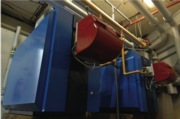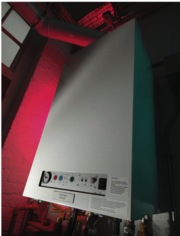Exploiting condensing technology in refurbishment projects

To avoid debris from the old heating system blocking the waterways of new condensing boilers to serve existing heating systems in Bromley Civic Centre, Clyde Energy Solutions suggested condensing boilers with a high water content and large waterways. The two new boilers have a combined output of nearly 500 kW.
There are undoubted benefits to installing condensing technology in existing buildings, but it is a much more complex matter than simply swapping over the boiler says STEPHEN LAWS.Under the new ADL2A — Approved Document Part L of the Building Regulations — gas-fired boilers in new buildings must have a gross seasonal efficiency of at least 84%. Since the UK is now a net gas importer, it is sensible to make the best use of this precious resource by utilising the best technologies. A new heating system would be equal to the task, designed to operate with low return-water temperatures to maximise the condensing effect. But what if we wish to install a condensing boiler into an existing system? First, there is no statutory need to do so. Under ADL2B, the minimum requirement for a new gas boiler connected to an existing system is a gross seasonal efficiency of 80%, elevated to 84% by system credits. Some conventional boilers currently available (such as the Clyde CK cast-iron range) will meet the 84% benchmark without the need for any system credits. Evidently, the motivation for using a condensing boiler in an existing system is the desire either to set a lead in reducing carbon emissions or to reduce running costs.
Illusion We should not be under any illusion that the task is simply a case of taking out a conventional boiler and replacing it with a condensing model. Many of the elements required may already be present, but the whole system needs to be considered as a new installation if we are to ensure the highest possible operating efficiency. A condensing boiler alone may well be more efficient than the unit it is replacing, because it will have a more efficient heat exchanger, and it will certainly extract more heat from the fuel. However, unless all the elements in the system are optimised to work together, the high-efficiency, energy-saving goal of operating in condensing mode will not be achieved. Let us take an overview of condensing technology itself. As one of the products of combustion, water is heated to steam and ejected with the other exhaust gas products. The latent energy used to change the water from liquid to vapour is thus wasted. A condensing boiler returning system water at low temperature to the boiler (that is, below the dew point of the exhaust gases, around 55°C for natural gas) will condense some of the water vapour and recover the latent heat. If we wish to examine this problem further, we can consider the condensed vapour running as a liquid film down the condensing (or secondary) heat exchanger and transferring sensible heat by means of conduction across the boundary layer. The heat-transfer coefficient of this process can be derived as the Nusselt number, and the rate of condensation can be predicted by use of the Jakob or phase-change number. How does this information assist us in applying a condensing boiler to an existing system? First, it reinforces the fact that the water vapour will not be condensed unless the system return water temperature is close to the dew point of the exhaust gases. This may require modifications to the system design. Alternatively, for a system with intermittent operation, it may be accepted that the return temperature will be depressed during a cold start-up, or may be reduced by a weather compensation control. Even when the system is at steady-state operation above the dew point, the enhanced surface area of the condensing heat exchanger will increase boiler efficiency. The fact that acidic condensate is in contact with the condensing heat exchanger dictates the use of corrosion-resistant materials. Currently, this means using more expensive and energy-intensive materials such as stainless steel, aluminium and copper rather than mild steel or cast iron. However, the additional cost of condensing boilers is rapidly falling, and the possible future use of polymers will accelerate this trend. Of course, the boiler flue is also transferring corrosive condensate, so similarly non-corrosive materials must be used (typically stainless steel or plastic if low temperatures are ensured). In an arrangement that utilises a mixture of condensing and non-condensing boilers, a common flue for all the boilers would be inappropriate and the condensing boilers will need to be separately flued. The low exhaust-gas temperatures and reduced buoyancy may require fan-assistance.
Design advantages There are, however, some design advantages for condensing boilers. They do not require a minimum return temperature to be maintained (for obvious reasons!), representing a considerable saving in pumps, valves and controls. Some also do not require a minimum flow rate. The flow from a condensing boiler can be directly compensated, reducing the costs of system compensation.

All boilers at Charterhouse School are progressively being replaced with wall-hung, stainless-steel condensing boilers supplied by Clyde Energy Systems. They will serve buildings spread out over a large site.
An emerging new generation of condensing boilers comprises floor-standing and wall-hung low-water content units. Examples of these are the Clyde CG wall-hung range and Modulex floor-standing range. Although manufactured from energy-intensive materials (stainless steel and aluminium, respectively), the reduced size of the heat exchangers for their output reduces misgivings about embodied energy levels. There are, of course, also the practical benefits for plant room space. Many of these boilers have in-built comprehensive controls, offering weather-compensation programs, cascade control of multiple boilers and even temperature control of discrete zones via mixing valves. These functions can be interfaced with a building-management system or even eliminate the need for an additional control system. Each section of a Modulex boiler is an independent module in itself, connected into a reverse-return configuration with its own down-firing pre-mix burner. Boilers can thus be sized to closely match the load (as required by ADL2), and the failure of one burner or module failure has a limited effect on heat generation — unlike two boilers each sized to meet two-thirds of demand! As with most of the new generation of boilers, the combustion air fan that is part of the pre-mix burner also gives fan-assistance to the exhaust gas products, so additional flue fans are rarely needed. CG boilers present the prospect of outputs of up to 180 kW output from a single boiler mounted on the wall. Linked together, they have an in-built cascade controller that will operate up to eight boilers. Ultimate control can be from a BMS, time clock or inside air sensor, or outdoor air sensor for direct weather-compensated operation. The high hydraulic resistance expected from such a compact heat exchanger is catered for by an internal pump.
Stephen Laws is technical director with Clyde Energy Systems.
Related links:










